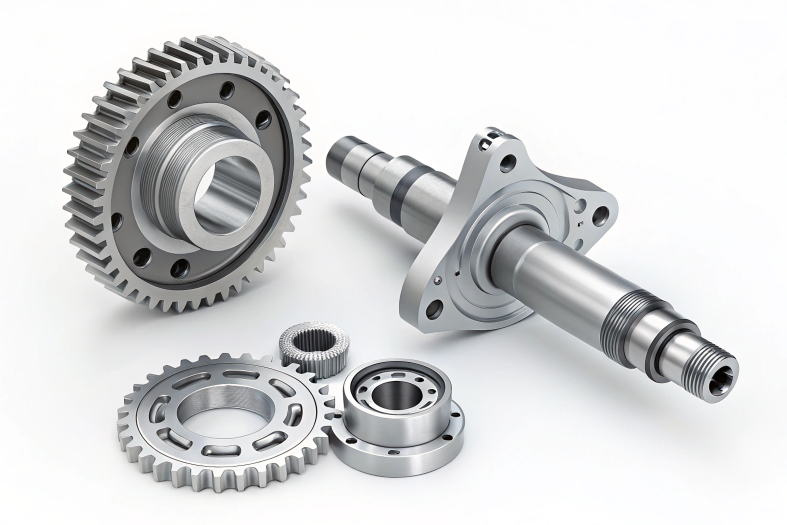Have you ever noticed how so many mechanical components around us require incredible precision to function properly? This got me thinking about CNC turned components—the unsung heroes of industrial manufacturing. Why? Because they offer exceptional accuracy, boost production efficiency, and reduce costs. If you’re exploring reliable ways to produce parts, CNC turning is definitely worth discussing!
Direct Answer:
CNC turned components deliver high precision, durability, cost efficiency, and fast production, ideal for mass manufacturing.

What Are CNC Turned Components?
Alright, first things first—what are we even talking about? CNC turned components are parts made using a machine called a CNC lathe. Imagine a workpiece spinning super fast while cutting tools do their magic, shaping it into precise parts. It’s like sculpting but on a whole new level of accuracy and efficiency. These parts are the backbone of precision machining, trusted by industries where even a tiny error can lead to major issues.
Key Benefits of CNC Turned Components
So, why are CNC turned components such a big deal? Here’s why:
1. Exceptional Precision
Picture this: tolerances as tight as ±0.001mm. Yep, that’s insanely precise! This kind of accuracy is crucial for industries like aerospace and medical devices, where even the smallest mistake can be catastrophic. With CNC turning, you can be confident every part is spot-on.
2. High Production Efficiency
Let’s face it—time is money. CNC turning speeds up production like you wouldn’t believe. The process is automated, meaning machines can run 24/7 without needing a coffee break (unlike us). That means faster turnaround times and more products hitting the market.
3. Cost-Effectiveness
Sure, setting up CNC machines might cost a bit upfront, but in the long run, they save tons of money. Why? Because automation minimizes errors, optimizes material use, and slashes labor costs. Whether you’re producing ten parts or ten thousand, the savings add up.
4. Material Versatility
CNC turning is like a jack-of-all-trades when it comes to materials. From metals like aluminum, steel, and titanium to plastics like ABS and even exotic materials like ceramics, there’s not much it can’t handle.
5. Customization and Complexity
Here’s where things get cool. CNC turning doesn’t just handle simple designs—it thrives on complexity. Whether it’s intricate threading or unique geometries, this process can bring even the wildest designs to life.
6. Enhanced Durability and Reliability
Precision manufacturing means fewer defects and consistent quality. The result? Components that last longer and perform better, even in tough environments like engines or heavy machinery.
7. Scalability for Small and Large Volumes
Whether you need a single prototype or a massive production run, CNC turning has your back. It’s flexible enough to handle both without breaking a sweat.

Applications of CNC Turned Components
You’re probably wondering where these parts actually get used. The answer? Almost everywhere. Here are some examples:
- Automotive: Think gear shafts, bushings, and fasteners.
- Medical Devices: Surgical instruments and implantable components.
- Aerospace: Aircraft fittings, housings, and critical hardware.
- Electronics: Connectors, heat sinks, and protective casings.
- Industrial Machinery: Bearings, rollers, and more.
Case Study: Success in Industry
Here’s a real example from our experience at ProMachine. A few months ago, we partnered with a mid-sized electric motor manufacturer struggling to improve their product’s efficiency. They needed precision components with tolerances as tight as ±0.005mm to enhance their motor’s performance.
We collaborated closely with their engineering team, fine-tuning the design and material specifications. After several iterations and prototypes, we delivered CNC-turned parts that met their exact requirements. The result? Their motors ran smoother, generated less heat, and consumed noticeably less energy—key improvements that gave their products a competitive edge in the market.
This project reminded us that CNC turning isn’t just about making parts; it’s about understanding customer challenges and delivering tailored solutions that truly make a difference.

Conclusion
CNC turned components aren’t just about precision and efficiency—they’re about solving real-world manufacturing challenges. They help businesses create reliable, high-quality parts that perform consistently, whether it’s in automotive engines, medical devices, or aerospace applications. The flexibility to handle complex designs, combined with scalability for both small and large orders, makes CNC turning a valuable solution for manufacturers worldwide.
If you’re exploring ways to improve your products or streamline production, CNC turning could be the answer. At ProMachine, we focus on understanding your specific needs and delivering solutions that make a real impact. Let’s connect and see how we can help bring your ideas to life with precision machining. Reach out today—we’re here to support your success!
FAQ:
What is CNC turning parts?
CNC turning parts are components produced using CNC (Computer Numerical Control) lathes. In this process, a workpiece is rotated while a cutting tool shapes it into the desired geometry. These parts are known for their precision and consistency, commonly used in industries like automotive, aerospace, and medical devices.
What are 3 advantages of a CNC machine?
- Precision: CNC machines achieve tight tolerances, ensuring high accuracy in manufacturing.
- Efficiency: They operate continuously with minimal downtime, significantly speeding up production.
- Versatility: CNC machines handle a variety of materials and complex designs, making them suitable for diverse applications.
What are the advantages of modular tooling units in CNC turning?
Modular tooling units offer:
- Flexibility: Easy swapping of tools for different operations.
- Efficiency: Reduced setup time, increasing production speed.
- Cost-Effectiveness: Tool reusability minimizes expenses over time.
What does CNC turning mean?
CNC turning is a machining process where a cutting tool shapes a rotating workpiece. It’s used to create cylindrical parts with high precision, such as shafts, bushings, and other components.
How to make CNC parts cheaper?
- Simplify Design: Reduce complexity to minimize machining time.
- Choose Standard Materials: Use commonly available materials to cut costs.
- Optimize Tolerances: Avoid over-specifying tight tolerances unless necessary.
- Batch Production: Order in larger quantities to benefit from economies of scale.
- Work with Experts: Partner with a reliable CNC machining provider to optimize costs while maintaining quality.


